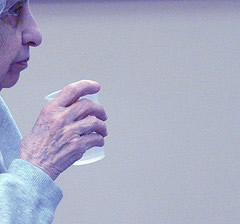The Independent
By Michael McCarthy
Friday, 18 July 2008
Men and women show differences in behaviour because their brains are physically distinct organs, new research suggests. Male and female brains appear to be constructed from markedly different genetic blueprints.
The differences in the circuitry that wires them up and the chemicals that transmit messages inside them are so great as to point to the conclusion that there is not just one kind of human brain, but two, according to recent neurological studies. [continue reading…]

It Ain’t Television… It’s Brain Surgery,” is a whimsical and enlightening first person account by Ray Farkas of his brain surgery operation.
Farkas, an Emmy award-winning producer and director, was diagnosed with Parkinson’s disease in May 2000. Not wanting to live the rest of his life with tremors and other symptoms, he decided to undergo Deep Brain Stimulation surgery, a procedure intended to improve his quality of life.
A TV animal to the core, Farkas naturally thought, “Why not make a TV documentary out of it?” Multiple cameras capture the action on the operating table as he flirts with nurses, tells bad jokes and breaks into a song.
As Farkas wrestles with his fear of surgery, he discovers remarkable dedication from his medical team and unabated love and support from his family and friends.
 Source: MediaStorm , Hat tip to Mind Hacks
Both schizophrenia and bipolar disorder can be disabling conditions, and both present clinically with significant mood and psychotic symptoms. These two illnesses also share genetic variants that might be involved in the predisposition to both disorders. A new study scheduled for publication in the July 15th issue of Biological Psychiatry sought to analyze the patterns of gene expression in the brains of individuals diagnosed with one of these disorders to search for a common “characteristic [genetic] signature.” [continue reading…]
 Researchers at the University of Pennsylvania School of Medicine have shown that mutations in two proteins associated with familial Alzheimer’s disease disrupt the flow of calcium ions within neurons. The two proteins, called PS1 and PS2 (presenilin 1 and 2), interact with a calcium release channel in an intracellular cell compartment. [continue reading…]
Researchers at the University of Pennsylvania School of Medicine have shown that mutations in two proteins associated with familial Alzheimer’s disease disrupt the flow of calcium ions within neurons. The two proteins, called PS1 and PS2 (presenilin 1 and 2), interact with a calcium release channel in an intracellular cell compartment. [continue reading…]


